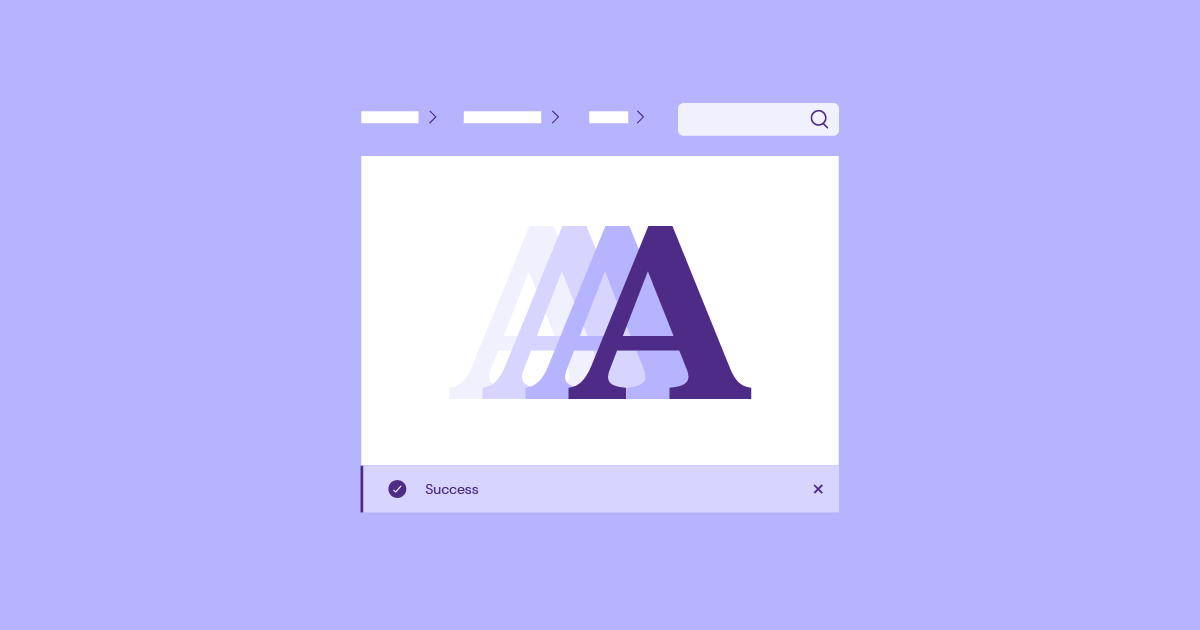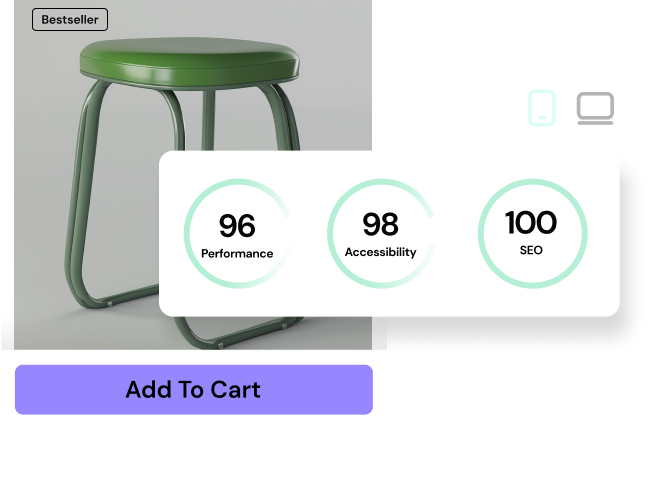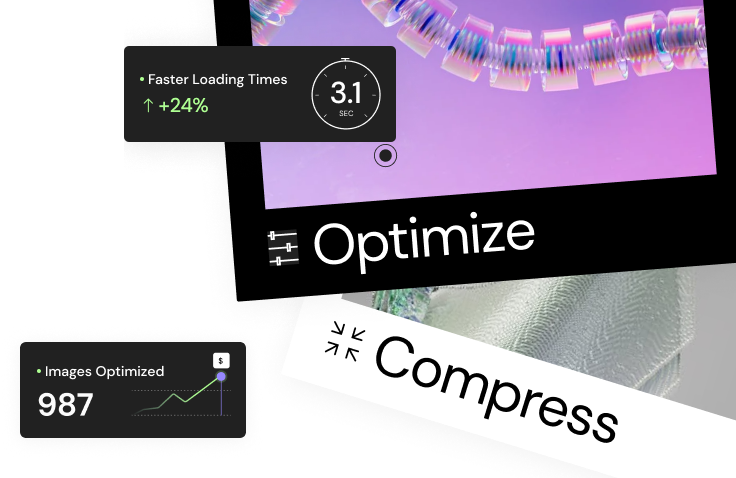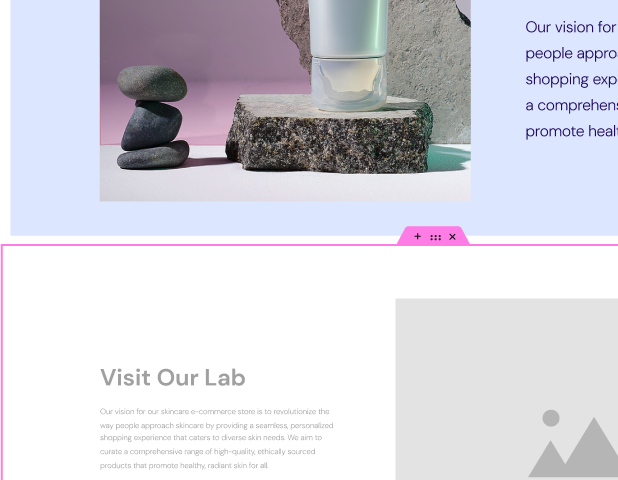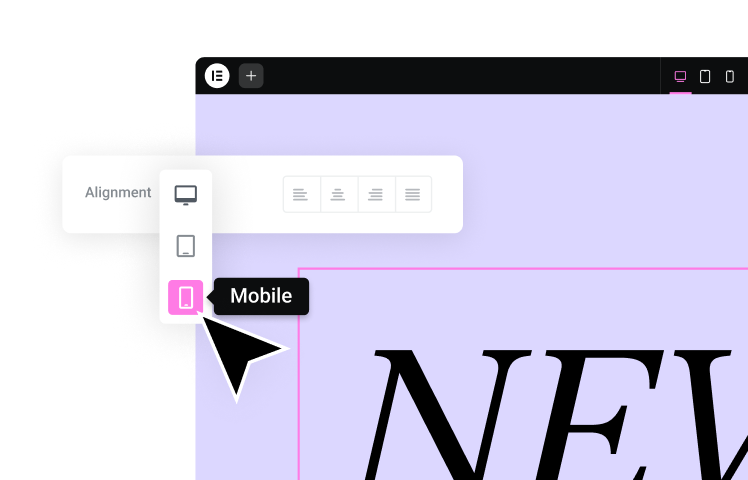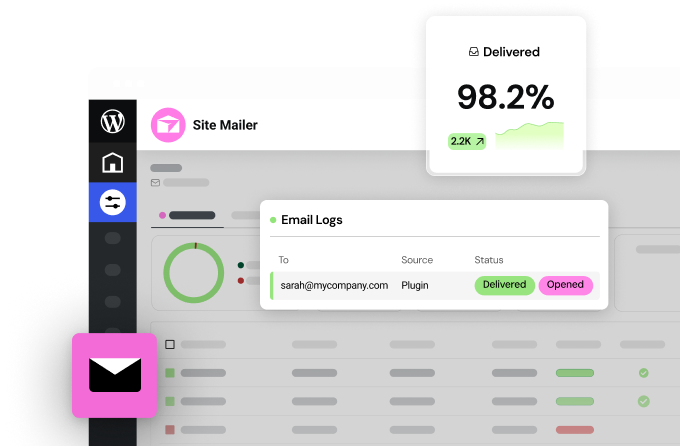Table of Contents
WCAG 2.2 adds nine new rules to the older 2.0 and 2.1 versions. The new rules focus on making content better for people with thinking, learning, and movement challenges.
When you follow these rules, you make your digital content open to everyone and meet legal rules at the same time. Organizations that adopt WCAG 2.2 can benefit from higher user engagement and improved retention rates.
What is WCAG 2.2
WCAG 2.2 brings new web accessibility rules that make websites easier to use for everyone. It adds to the older WCAG 2.0 and 2.1 standards. The rules come in three levels (A, AA, AAA), helping teams pick the right goals for their needs.
The guidelines follow four basic rules:
- Make content easy to see and hear
- Make sites simple to use
- Keep content clear and simple
- Make sites work well with all tools
WCAG 2.2 adds nine new rules that focus on improving sites for mobile users and people with thinking or memory challenges. The UK requires all public-sector websites to be WCAG 2.2 compliant by October 2024.
Release date and development process
The W3C launched WCAG 2.2 on October 5, 2023, bringing new web access rules after a long development. No laws require you to follow these rules right now.
Countries will likely add these rules bit by bit, and web tools are getting ready to handle the new needs. These standards add nine new criteria and improve upon previous WCAG versions.
Importance of web accessibility
Making websites work for everyone is vital today. About 1 in 7 people worldwide have a disability, while 1 in 4 U.S. adults struggle to use websites easily.
In 2024, 5.18 billion people actively use the internet globally, making web accessibility more critical than ever.
We need to make websites that everyone can use:
- Almost 97% of website home pages fail basic access standards
- Only 3 out of 100 websites are fully usable by people with disabilities
- More companies face lawsuits when their sites exclude people with disabilities
Key Changes in WCAG 2.2
WCAG 2.2 introduces nine new success criteria to improve web accessibility, primarily focusing on users with cognitive disabilities, users with low vision, and mobile users. These new criteria are distributed across the three conformance levels:
- Level A (two new criteria):
- Consistent Help: Help mechanisms (e.g., FAQs and contact forms) must be consistently located across pages.
- Redundant Entry: Users should not have to enter the same information multiple times in forms.
- Level AA (four new criteria):
- Focus Appearance (Minimum): The focus indicator must be clearly visible and not obscured by other page elements.
- Focus Not Obscured (Minimum): Focused elements must remain at least partially visible.
- Dragging Movements: Functionality that involves dragging must also provide an alternative interaction method.
- Target Size (Minimum): Interactive elements must have a minimum target size (24×24 CSS pixels) for easier interaction.
- Level AAA (three new criteria):
- Focus Not Obscured (Enhanced): Focused elements must be completely visible.
- Accessible Authentication (Minimum): Authentication processes should not rely solely on memorization; they should provide accessible alternatives.
- Accessible Authentication (Enhanced): Stronger requirements for accessible authentication, minimizing cognitive barriers.
In addition to these new criteria, WCAG 2.2 removes Success Criterion 4.1.1 (Parsing) because it is no longer relevant to modern web browsers and assistive technologies.
Importantly, WCAG 2.2 is backward compatible with WCAG 2.0 and 2.1. Websites conforming to WCAG 2.2 will also meet the requirements of the previous versions (with the exception of the removed parsing criterion). This ensures that existing accessibility efforts remain valid while encouraging the adoption of the latest enhancements.
Understanding the Four Principles of WCAG
WCAG 2.2 is built on four fundamental principles that ensure web content is accessible to people with a wide range of disabilities:
- Perceivable: Users must be able to perceive the information presented. This means providing text alternatives for non-text content, using sufficient color contrast, and creating content that can be presented in different ways without losing information or structure.
- Operable: Users must be able to operate the interface. This includes ensuring keyboard accessibility, providing sufficient time for users to interact, and avoiding content that could cause seizures.
- Understandable: Users must be able to understand the information and how to use the interface. This involves using clear and simple language, predictable navigation, and error prevention mechanisms.
- Robust: Content must be robust enough to be interpreted reliably by a wide variety of user agents, including assistive technologies. This requires using valid code and following accessibility best practices.
These four principles (POUR) provide the foundation for WCAG’s success criteria. Each principle is further elaborated with specific guidelines and success criteria at different conformance levels (A, AA, and AAA).
Detailed Breakdown of New Success Criteria
WCAG 2.2 adds new rules to make websites easier to use. When you click or tab through a website, a visible outline shows where you’re on the page. These outlines must be clear and not hidden by other content.
If you need to drag items on a website, there must be another way to move them without dragging. Also, any buttons or links you can click must be at least 24×24 CSS pixels in size, making them easier to tap or click. The update includes nine new criteria to improve web accessibility standards.
2.4.11 Focus Appearance (Minimum) (AA)
When using a keyboard to navigate a website, you need to be able to see where you are at all times. The focused item on the page must stay at least partly visible. Headers or popups at the top or bottom of the page shouldn’t block your view of what you’re selecting. Meeting these requirements helps achieve WCAG 2.2 AA conformance standards.
To keep focused items visible:
- Build page elements that don’t let headers hide focused content
- Add space around scroll areas
- Make sure focus works well on all screen sizes
2.4.12 Focus Not Obscured (Minimum) (AA)
When keyboard users focus on parts of a website, they need to see what they’re selecting. This means any focused item must stay at least partly visible on the screen. User-opened content will not fail accessibility requirements if it doesn’t persist after focus changes. This matters most for websites that use overlays or content management tools.
| Scenario | Solution |
| Sticky headers | Use scroll padding |
| Cookie banners | Implement modal dialogs |
| Lightboxes | Manage z-index properly |
| Overlays | Add dismiss controls |
| Mobile menus | Guarantee responsive visibility |
2.4.13 Focus Not Obscured (Enhanced) (AAA)
The AAA focus rule builds on basic focus requirements by ensuring nothing blocks a focused element. When making responsive and accessible websites, you need to check that:
- Users can see all parts of focused items when using the keyboard
- Elements like floating headers and pop-ups don’t cover focused items
- Everything works well at different screen sizes and zoom levels
Unlike Level AA requirements, this criterion fails if any portion of a focused element becomes obscured by other content.
2.5.7 Dragging Movements (AA)
Any dragging features on a website must have a simpler option that works with just one click or tap. Users who can’t make dragging motions need other ways to upload files, change the order of items, or use controls. New WCAG 2.2 standards require testing of alternative dragging movement methods. Make sure people can use a keyboard, too, while keeping the drag options for those who want them.
2.5.8 Target Size (Minimum) (AA)
When users click or tap interactive elements with a pointer device, they must be at least 24×24 CSS pixels. This site makes it easier for people to select and activate buttons, links, and other clickable items.
Some items don’t need to follow this rule, such as text links within paragraphs, browser controls, and elements that must be smaller to work properly. This larger target size helps people who’ve shaky hands or trouble making precise movements.
It also makes websites more user-friendly for people using touchscreens or special input tools. If targets are undersized, they need to have sufficient spacing around them to prevent accidental activation of nearby elements.
3.2.6 Consistent Help (A)
Users need to find help quickly when they use a website. That’s why WCAG 2.2 adds a new rule called “Consistent Help.”
This rule means that help options like contact forms, phone numbers, FAQs, and chatbots must stay in the same spot on every page. The help must keep its place even when the website changes size on different screens. Remember that this requirement only applies to pages where help mechanisms exist, not every page on your website.
3.3.7 Redundant Entry (A)
Digital forms shouldn’t allow users to type the same details more than once. This creates extra work and can be annoying.
To make forms better for everyone:
- Let forms fill in data that users already typed
- Save and use information within the same form session
- Only ask users to enter things twice when needed for security or checking
Note that browser autofill features do not count as an acceptable solution for avoiding redundant data entry.
3.3.8 Accessible Authentication (Minimum) (AA)
Login methods need to be easy for everyone to use, including people with learning and memory issues. If your site asks users to remember or type complex passwords, you must also offer simpler ways to log in.
You can let users sign in through email links, fingerprints, single sign-on, or security keys. Make sure users can also use password managers and copy-paste their login details. These options help make your site more accessible to all users. Authentication processes that require users to remember, manipulate, or transcribe information can be especially challenging for users with cognitive disabilities.
3.3.9 Accessible Authentication (Enhanced) (AAA)
WCAG 2.2’s AAA-level login rules make signing in easier for everyone. Users shouldn’t have to pass memory or thinking tests to log in.
Single sign-on systems help streamline the login process for users.
Instead, websites need to offer simple ways to sign in, such as:
- Face or fingerprint scans
- Special security devices
- Email links to click
- Tools that fill in passwords
These options help more people access websites without barriers.
Implementing WCAG 2.2 in Web Design
To effectively implement WCAG 2.2, it’s essential to integrate accessibility considerations throughout the web design process. This involves a combination of best practices, appropriate tools, and a commitment to ongoing testing and improvement.
Best Practices for Designers
Designers play a crucial role in creating accessible websites. Here are some key best practices to keep in mind:
- Visual Design:
- Ensure sufficient color contrast (at least 4.5:1 for normal text and 3:1 for large text) to make text readable for users with low vision.
- Use clear visual cues to indicate focus states and interactive elements.
- Design with a mobile-first approach, ensuring that layouts and interactive elements are optimized for smaller screens and touch interactions.
- Code and Structure:
- Use semantic HTML to provide structure and meaning to content, making it easier for assistive technologies to interpret.
- Ensure keyboard accessibility by making all functionality available using the keyboard alone.
- Provide clear and concise page titles and headings to help users understand the content and navigate the site.
Website builders like Elementor can assist designers in implementing these best practices by providing accessible templates, components, and design options.
Tools for Checking WCAG 2.2 Compliance
A variety of tools can help you assess and improve your website’s accessibility:
- Automated Testing Tools: These tools can quickly scan your website and identify potential accessibility issues. Popular options include:
- WAVE by WebAIM
- axe by Deque
- Lighthouse (built into Chrome DevTools)
- Manual Testing: While automated tools are helpful, they cannot catch all accessibility issues. Manual testing, including using screen readers and keyboard navigation, is essential to ensure a comprehensive evaluation.
- Accessibility Overlays: These tools offer a quick fix by adding accessibility features to a website. However, they have limitations and should not be solely relied upon for WCAG 2.2 compliance.
Pro Tip: Elementor’s built-in accessibility features, such as color contrast checkers and landmark roles, can help designers and developers identify and address potential issues early in the design process.
A Comprehensive Approach
Implementing WCAG 2.2 requires a combined approach that integrates accessibility into every stage of the web design process. This includes:
- Planning: Consider accessibility from the initial planning stages, incorporating it into design mockups and prototypes.
- Development: Use accessibility best practices during development and conduct regular accessibility testing throughout the process.
- Testing: Utilize both automated and manual testing methods to identify and address accessibility issues.
- Maintenance: Review and update your website regularly to ensure ongoing compliance with WCAG 2.2 as content and functionality evolve.
WCAG 2.2 and SEO
Following WCAG 2.2 guidelines not only improves accessibility for users with disabilities but also benefits your website’s search engine optimization (SEO). Many accessibility best practices align with SEO principles, creating a win-win situation for both users and search engines.
How Accessibility Impacts Search Rankings
Search engines aim to provide relevant and user-friendly content to their users. Accessible websites are inherently more user-friendly, making it easier for search engines to understand and rank your content. Here’s how:
- Improved Crawlability: Semantic HTML, proper headings, and clear navigation – all essential for accessibility – help search engines understand your website’s structure and content.
- Enhanced User Experience: Accessible websites offer a better experience for all users, including those with disabilities. This can lead to increased engagement, longer visit durations, and lower bounce rates, all of which are positive signals for search engines.
- Content Accessibility: Providing alternative text for images, transcripts for videos, and captions for audio not only benefits users with disabilities but also allows search engines to index and understand this content.
Optimizing for Accessibility and SEO
Here are some key elements that benefit both accessibility and SEO:
| Element | SEO Benefit | Accessibility Benefit |
| Alt Text | Image indexing | Screen reader descriptions |
| Headings | Content hierarchy | Navigation structure |
| Clear URLs | Crawlability | User orientation |
| Semantic HTML | Content understanding | Assistive technology support |
By focusing on these elements and implementing WCAG 2.2 guidelines, you can create a website that is both accessible and optimized for search engines.
Remember, accessibility and SEO are not mutually exclusive; they complement each other to create a better online experience for everyone.
WCAG 2.2 vs. Previous Versions
WCAG 2.2 adds nine new rules and removes one old rule (4.1.1 Parsing). This update includes better rules for people with thinking challenges, poor vision, and mobile users – areas that WCAG 2.0 and 2.1 didn’t fully cover.
Any website that follows WCAG 2.2 rules will also meet the older standards, making it a smart choice for improving your website’s access for all users.
Comparison with WCAG 2.1
WCAG 2.2 adds nine new rules and removes one old rule about parsing, making 86 rules in total. The new version makes websites easier to use by improving:
- Phone and tablet touch controls
- Support for people with learning needs
- Simple login options and basic movements
The latest version emphasizes cognitive accessibility features for a more inclusive web experience.
Comparison with WCAG 2.0
WCAG 2.2 brings key changes to the older WCAG 2.0 standards for web access. The main updates focus on mobile design and testing:
| WCAG 2.2 | WCAG 2.0 |
| 9 new success criteria | Basic access rules |
| Better mobile support | Basic mobile rules |
| Focus on thinking tasks | Simple thinking aids |
| No parsing rules | Includes parsing |
| Works with old standards | Base standard |
These updates match today’s web needs while keeping old sites working. The upgraded guidelines reflect a commitment to emerging technologies and will support modern platforms like web XR and voice input.
Future of Web Accessibility
While WCAG 2.2 is the current standard, the field of web accessibility is constantly evolving. The next major iteration, WCAG 3.0, is currently under development and promises to bring significant changes:
- WCAG 3.0 Preview: WCAG 3.0 aims to simplify accessibility guidelines and improve support for users with cognitive disabilities. It will introduce a graded scoring system, a broader scope for different technologies, and a more agile approach to adapting to emerging technologies.
- Emerging Technologies and Accessibility: Technologies like artificial intelligence (AI) and voice control are already impacting web accessibility. AI-powered tools can automate accessibility testing and personalize user experiences, while voice control enhances navigation for users with motor impairments.
It’s important to stay informed about the latest developments in web accessibility and be prepared to adapt to future changes. By embracing innovation and prioritizing inclusivity, we can create a web that is truly accessible to everyone.
Resources for Learning and Implementing WCAG 2.2
Numerous resources are available to help you learn about WCAG 2.2 and implement it effectively:
- Official W3C Documentation: The World Wide Web Consortium (W3C) provides comprehensive documentation, including quick references, detailed guidelines, and technical specifications. ([Link to W3C WCAG 2.2 documentation])
- Training and Certification: Several organizations offer training courses and certifications on web accessibility, including:
- Accessibility Testing Tools: A variety of tools are available to help you test your website’s compliance with WCAG 2.2, including automated scanners, browser extensions, and screen readers. Some popular options include:
While the tools mentioned above can help identify and address accessibility issues, it’s important to be wary of “accessibility overlays” – quick-fix solutions that claim to make websites accessible with minimal effort.
While overlays can address some basic accessibility issues, such as color contrast and keyboard navigation, they often fail to address the more complex aspects of WCAG 2.2, particularly those related to dynamic content, focus management, and ARIA attributes.
Pros and Cons of Accessibility Overlays
- Pros:
- Quick and easy to implement.
- It may be a more affordable option for small businesses with limited resources.
- Can provide a temporary solution while more comprehensive accessibility improvements are underway.
- Cons:
- It may not fully address all WCAG 2.2 requirements.
- It can interfere with assistive technologies and create new usability issues for people with disabilities.
- This may raise privacy concerns due to data collection practices.
Native Implementation vs. Overlay Solutions
The preferred approach is always to build accessibility directly into your website’s code (“native implementation”). This ensures better compatibility with assistive technologies, improved performance, and more sustainable accessibility solutions.
While overlays can be helpful in certain situations, they should not be considered a replacement for comprehensive accessibility testing and implementation.
Common Challenges in WCAG 2.2 Compliance
Implementing WCAG 2.2 can be challenging for organizations of all sizes. Here are some of the most common obstacles and how to overcome them:
1. Legacy Systems and Technical Debt
Outdated websites and applications often pose significant accessibility challenges. Updating legacy code can be complex and time-consuming, especially when dealing with limited documentation and resources.
- Solution: Prioritize a gradual approach to updating legacy systems. Focus on high-traffic areas and critical functionalities first. Conduct a thorough audit to identify the most pressing accessibility issues and develop a phased remediation plan. Consider using automated testing tools to identify low-hanging fruit and prioritize fixes.
Lucky for you, modern website builders like Elementor can help mitigate technical challenges by providing a solid foundation for accessibility and reducing the need for extensive custom coding.
2. Lack of Accessibility Knowledge and Awareness
Many organizations lack the knowledge and awareness needed to implement WCAG 2.2 effectively. This can lead to design and development decisions that inadvertently create accessibility barriers.
- Solution: Invest in accessibility training for designers, developers, content creators, and project managers. Foster a culture of accessibility by raising awareness about its importance and providing ongoing support and resources. Encourage collaboration with accessibility experts and engage with the disability community to gain valuable insights.
Meanwhile, Elementor’s user-friendly interface and accessibility features can empower designers and developers with limited accessibility knowledge to create more inclusive websites.
3. Content Accessibility
Creating accessible content requires careful consideration of various formats, including text, images, videos, and audio. Ensuring that all content is perceivable, operable, understandable, and robust can be a significant undertaking.
- Solution: Develop clear accessibility guidelines for content creators. Provide training on creating alternative text for images, captions for videos, transcripts for audio, and accessible documents. Implement content management systems that support accessibility features and integrate accessibility checks into content workflows.
4. Limited Resources and Competing Priorities
Implementing WCAG 2.2 can require significant resources, including time, budget, and personnel. Organizations may face challenges in prioritizing accessibility amidst competing business objectives.
- Solution: Make a strong business case for accessibility by highlighting its benefits, including increased audience reach, improved brand reputation, and reduced legal risk. Advocate for dedicated resources and integrate accessibility into project budgets and timelines.
5. Keeping Up with Evolving Standards
WCAG is a living standard that evolves over time. Staying up-to-date with the latest guidelines and best practices can be challenging, especially for organizations with limited resources.
- Solution: Establish a process for monitoring updates to WCAG and related accessibility standards. Subscribe to accessibility newsletters, attend industry events, and engage with the accessibility community to stay informed.
Benefits of WCAG 2.2 Compliance
Making your website follow WCAG 2.2 rules helps everyone use it better. People with all types of needs—including those who have trouble thinking, learning, or moving—can more easily access your content.
When you make these changes, more people can use your site. Plus, your brand looks better because you care about helping all users, which builds trust with customers.
The new standard provides 9 additional success criteria compared to the previous WCAG 2.1 version.
Improved user experience
WCAG 2.2 makes websites easier for everyone to use. By prioritizing users and following clear steps, you can create simpler sites that work better for everyone. The guidelines focus on basic human dignity and creating equitable experiences for all users.
- Simple login steps and forms that are quick to fill out
- Clear visual guides and bigger buttons for easier clicking
- Standard help tools that make users feel more confident
Broader audience reach
Making your website accessible helps you reach more people online. This includes over 1 billion people with disabilities and older adults who control $77 trillion in spending power.
When you follow WCAG 2.2 rules, you can do business in Europe, the UK, and the US while meeting legal standards. Your content will work better for everyone and keep you ahead of new laws.
Enhanced brand reputation
Making your website accessible helps your brand look better to today’s buyers. When you follow web rules like WCAG 2.2, you show that you care about all users. This brings big benefits:
- Most buyers (92%) like to buy from companies that help others
- Many users (73%) say they’d switch to brands with easier-to-use websites
- People see your company as smart and modern when you make your site work for everyone
WCAG 2.2 and Mobile Accessibility
Making mobile sites accessible means keeping a few key things in mind. First, make sure buttons and links are big enough to tap easily. Let users view content in both portrait and landscape modes.
Keep menus and controls in the same place as users move between pages. Add clear outlines to show which items are selected. Ensure users can easily log in on small screens.
When you adjust your design for different screen sizes, remember to keep all accessibility features working well, especially for touch screens and different viewing sizes.
Mobile-specific considerations
Making mobile apps accessible means following clear rules in WCAG 2.2. These rules help users tap buttons, use screen readers, and view content on all screen sizes.
Key points include:
- Touch areas must be at least 24×24 pixels (good) or 44×44 pixels (best) to help users tap easily
- Screen readers and other tools must work well on all mobile devices
- Apps must work smoothly on many screen sizes through careful testing
Responsive design and accessibility
Responsive design and accessibility work together to make websites easy to use on phones and tablets. Your design should adjust smoothly to different screen sizes.
Make sure buttons and links are big enough to tap – at least 44×44 pixels. People should be able to use your site whether they tap, swipe, or use other controls. Let them view content in portrait or landscape mode. And always give simple options for those who can’t make complex finger movements.
Integrating WCAG 2.2 into Development Workflows
Add WCAG 2.2 checks to your sprints by setting up automated tools in your testing pipeline. Include accessibility testing during code reviews, and run scans with your other tests.
Testing early and often helps find problems quickly, which saves time and money to fix them.
Agile development and accessibility
Adding WCAG 2.2 rules to agile projects requires clear steps across all stages. A team leader must guide the process to ensure that everything meets the standards.
To blend these rules well:
- Add clear access goals when planning sprints
- Check code and test for access issues
- Give teams WCAG 2.2 training and helpful tools
Continuous integration and automated testing
Automated testing in your CI/CD pipeline helps catch accessibility issues early. When you build your code, add tools like Siteimprove or Axe to check WCAG 2.2 rules. Set up regular checks and monitor how well your site follows these rules.
Since automated tools can’t find all problems, make sure to test your site by hand too.
WCAG 2.2 and Content Management Systems
Popular website builders like Elementor, WordPress, and others offer tools to help meet WCAG 2.2 rules.
Elementor and WCAG 2.2
Elementor, known for its visual design capabilities, also provides features like keyboard navigation support, ARIA attributes, and accessible color palettes, making it easier to build compliant websites.
In addition, Elementor is actively working to improve its accessibility features and provide resources to help users build inclusive websites. Their commitment to WCAG compliance is evident in their recent updates and documentation.
WordPress and WCAG 2.2
WordPress comes with basic access features and extra add-ons you can install.
WordPress runs more than a third of all websites today. This means its focus on WCAG 2.2 AA rules helps make the web open to everyone.
To match WordPress with WCAG 2.2 rules, you need to:
- Pick themes that work well for all users
- Check plugins to make sure they work for everyone
- Run regular checks to test how easy your site is to use
Conclusion
WCAG 2.2 marks a significant step forward in web accessibility. It introduces new guidelines that prioritize inclusivity for users with cognitive, learning, and motor disabilities. By embracing these guidelines, organizations can create digital experiences that are accessible and enjoyable for everyone, regardless of their abilities.
Key Takeaways:
- WCAG 2.2 introduces nine new success criteria, focusing on mobile, cognitive, and visual accessibility.
- These guidelines are backward compatible with previous versions, ensuring that existing accessibility efforts remain valid.
- Implementing WCAG 2.2 benefits users, enhances brand reputation, improves SEO, and ensures legal compliance.
- The future of web accessibility is constantly evolving, with WCAG 3.0 on the horizon and emerging technologies like AI and voice control playing an increasing role.
Don’t wait for legal mandates or user complaints to prioritize accessibility. Take action today to make your digital content welcoming and usable for everyone.
- Conduct regular accessibility audits: Identify and address accessibility barriers on your websites and applications.
- Integrate accessibility into your design and development workflows: Ensure that accessibility is considered at every stage of the process.
- Provide training and resources: Empower your team with the knowledge and tools they need to create accessible content.
- Stay informed: Keep up-to-date with the latest developments in web accessibility and be prepared to adapt to future changes.
By embracing WCAG 2.2 and prioritizing inclusivity, you can contribute to a more accessible and equitable digital world for all.
Looking for fresh content?
By entering your email, you agree to receive Elementor emails, including marketing emails,
and agree to our Terms & Conditions and Privacy Policy.
